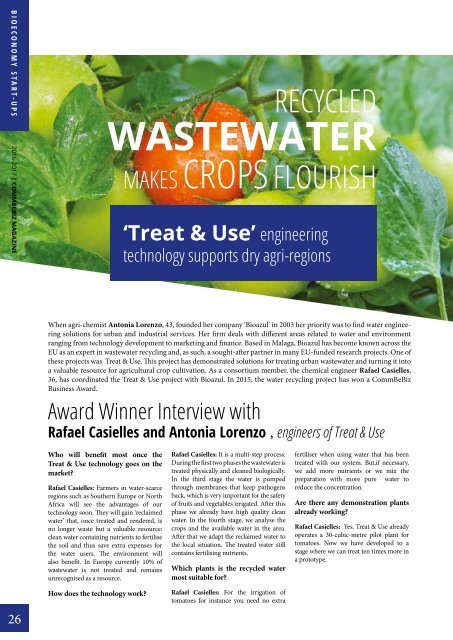BE INNOVATION_commbebiz-magazine 2016_2017
Create successful ePaper yourself
Turn your PDF publications into a flip-book with our unique Google optimized e-Paper software.
BIOECONOMY START-UPS<br />
<strong>2016</strong>-<strong>2017</strong> | COMM<strong>BE</strong>BIZ MAGAZINE<br />
RECYCLED<br />
WASTEWATER<br />
MAKES CROPS FLOURISH<br />
‘Treat & Use’ engineering<br />
technology supports dry agri-regions<br />
When agri-chemist Antonia Lorenzo, 43, founded her company ‘Bioazul’ in 2003 her priority was to find water engineering<br />
solutions for urban and industrial services. Her firm deals with different areas related to water and environment<br />
ranging from technology development to marketing and finance. Based in Malaga, Bioazul has become known across the<br />
EU as an expert in wastewater recycling and, as such, a sought-after partner in many EU-funded research projects. One of<br />
these projects was Treat & Use. This project has demonstrated solutions for treating urban wastewater and turning it into<br />
a valuable resource for agricultural crop cultivation. As a consortium member, the chemical engineer Rafael Casielles,<br />
36, has coordinated the Treat & Use project with Bioazul. In 2015, the water recycling project has won a CommBeBiz<br />
Business Award.<br />
Award Winner Interview with<br />
Rafael Casielles and Antonia Lorenzo , engineers of Treat & Use<br />
Who will benefit most once the<br />
Treat & Use technology goes on the<br />
market?<br />
Rafael Casielles: Farmers in water-scarce<br />
regions such as Southern Europe or North<br />
Africa will see the advantages of our<br />
technology soon. They will gain ‘reclaimed<br />
water’ that, once treated and rendered, is<br />
no longer waste but a valuable resource:<br />
clean water containing nutrients to fertilise<br />
the soil and thus save extra expenses for<br />
the water users. The environment will<br />
also benefit. In Europe currently 10% of<br />
wastewater is not treated and remains<br />
unrecognised as a resource.<br />
Rafael Casielles: It is a multi-step process.<br />
During the first two phases the wastewater is<br />
treated physically and cleaned biologically.<br />
In the third stage the water is pumped<br />
through membranes that keep pathogens<br />
back, which is very important for the safety<br />
of fruits and vegetables irrigated. After this<br />
phase we already have high quality clean<br />
water. In the fourth stage, we analyse the<br />
crops and the available water in the area.<br />
After that we adapt the reclaimed water to<br />
the local situation. The treated water still<br />
contains fertilising nutrients.<br />
Which plants is the recycled water<br />
most suitable for?<br />
fertiliser when using water that has been<br />
treated with our system. But,if necessary,<br />
we add more nutrients or we mix the<br />
preparation with more pure water to<br />
reduce the concentration.<br />
Are there any demonstration plants<br />
already working?<br />
Rafael Casielles: Yes. Treat & Use already<br />
operates a 30-cubic-metre pilot plant for<br />
tomatoes. Now we have developed to a<br />
stage where we can treat ten times more in<br />
a prototype.<br />
26<br />
How does the technology work?<br />
Rafael Casielles: For the irrigation of<br />
tomatoes for instance you need no extra


